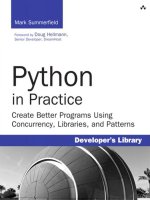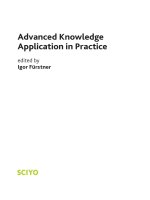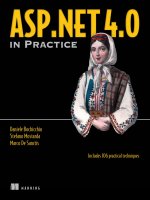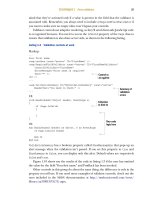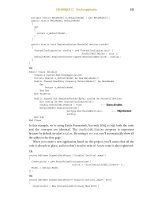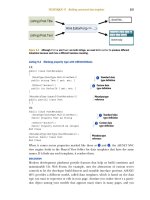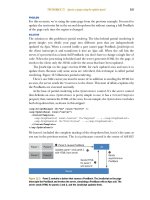Ebook - AWP python in practice aug 2013
Bạn đang xem bản rút gọn của tài liệu. Xem và tải ngay bản đầy đủ của tài liệu tại đây (2.33 MB, 323 trang )
ptg11539634
ptg11539634
Python in Practice
ptg11539634
T
he Developer’s Library Series from Addison-Wesley provides
practicing programmers with unique, high-quality references and
tutorials on the latest programming languages and technologies they
use in their daily work. All books in the Developer’s Library are written by
expert technology practitioners who are exceptionally skilled at organizing
and presenting information in a way that’s useful for other programmers.
Developer’s Library books cover a wide range of topics, from open-
source programming languages and databases, Linux programming,
Microsoft, and Java, to Web development, social networking platforms,
Mac/iPhone programming, and Android programming.
Visit developers-library.com for a complete list of available products
Developer’s Library Series
ptg11539634
Python in Practice
Create Better Programs Using
Concurrency, Libraries, and Patterns
Mark Summerfield
Upper Saddle River, NJ
·
Boston
·
Indianapolis
·
San Francisco
p New York
·
Toronto
·
Montreal
·
London
·
Munich
·
Paris
·
Madrid p
Capetown
·
Sydney
·
Tokyo
·
Singapore
·
Mexico City
ptg11539634
Many of the designationsused by manufacturersand sellersto distinguish their products are claimed as
trademarks. Where those designations appear in this book, and the publisher was aware of a trademark
claim, the designations have been printed with initial capital letters or in all capitals.
The author and publisher have taken care in the preparation of this book, but make no expressed or
implied warranty of any kind and assume no responsibility for errors or omissions. No liability is
assumed for incidental or consequential damages in connection with or arising out of the use of the
information or programs contained herein.
The publisher offers excellent discounts on this book when ordered in quantity for bulk purchases
or special sales, which may include electronic versions and/or custom covers and content particular
to your business, training goals, marketing focus, and branding interests. For more information,
please contact:
U.S. Corporate and Government Sales
(800) 382-3419
For sales outside the United States, please contact:
International Sales
Visit us on the Web: informit.com/aw
Library of Congress Control Number: 2013942956
Copyright
©
2014 Qtrac Ltd.
All rights reserved. Printed in the United States of America. This publication is protected by
copyright, and permission must be obtained from the publisher prior to any prohibited reproduction,
storage in a retrieval system, or transmission in any form or by any means, electronic, mechanical,
photocopying, recording, or likewise. To obtain permission to use material from this work, please
submit a written request to Pearson Education, Inc., Permissions Department, One Lake Street, Upper
Saddle River, New Jersey 07458, or you may fax your request to (201) 236-3290.
ISBN-13: 978-0-321-90563-5
ISBN-10: 0-321-90563-6
Text printed in the United States on recycled paper at RR Donnelley in Crawfordsville, Indiana.
First printing, August 2013
ptg11539634
This book is dedicated to
free and open-source software contributors
everywhere—your generosity benefits us all.
ptg11539634
This page intentionally left blank
ptg11539634
Contents at a Glance
Contents
ix
Foreword
xiii
Introduction
1
Chapter 1. Creational Design Patterns in Python
5
Chapter 2. Structural Design Patterns in Python
29
Chapter 3. Behavioral Design Patterns in Python
73
Chapter 4. High-Level Concurrency in Python
141
Chapter 5. Extending Python
179
Chapter 6. High-Level Networking in Python
203
Chapter 7. Graphical User Interfaces with Python and Tkinter
231
Chapter 8. OpenGL 3D Graphics in Python
263
Appendix A. Epilogue
283
Appendix B. Selected Bibliography
285
Index
289
www.qtrac.eu/pipbook.html
ptg11539634
This page intentionally left blank
ptg11539634
Contents
Foreword
xiii
Introduction
1
Acknowledgments 3
Chapter 1
.
Creational Design Patterns in Python
5
1.1. Abstract Factory Pattern 5
1.1.1. A Classic Abstract Factory 6
1.1.2. A More Pythonic Abstract Factory 9
1.2. Builder Pattern 11
1.3. Factory Method Pattern 17
1.4. Prototype Pattern 24
1.5. Singleton Pattern 26
Chapter 2
.
Structural Design Patterns in Python
29
2.1. Adapter Pattern 29
2.2. Bridge Pattern 34
2.3. Composite Pattern 40
2.3.1. A Classic Composite/Noncomposite Hierarchy 41
2.3.2. A Single Class for (Non)composites 45
2.4. Decorator Pattern 48
2.4.1. Function and Method Decorators 48
2.4.2. Class Decorators 54
2.4.2.1. Using a Class Decorator to Add Properties 57
2.4.2.2. Using a Class Decorator Instead of Subclassing 58
2.5. Façade Pattern 59
2.6. Flyweight Pattern 64
2.7. Proxy Pattern 67
Chapter 3
.
Behavioral Design Patterns in Python
73
3.1. Chain of Responsibility Pattern 74
3.1.1. A Conventional Chain 74
3.1.2. A Coroutine-Based Chain 76
3.2. Command Pattern 79
ix
ptg11539634
3.3. Interpreter Pattern 83
3.3.1. Expression Evaluation with eval() 84
3.3.2. Code Evaluation with exec() 88
3.3.3. Code Evaluation Using a Subprocess 91
3.4. Iterator Pattern 95
3.4.1. Sequence Protocol Iterators 95
3.4.2. Two-Argument iter() Function Iterators 96
3.4.3. Iterator Protocol Iterators 97
3.5. Mediator Pattern 100
3.5.1. A Conventional Mediator 101
3.5.2. A Coroutine-Based Mediator 104
3.6. Memento Pattern 106
3.7. Observer Pattern 107
3.8. State Pattern 111
3.8.1. Using State-Sensitive Methods 114
3.8.2. Using State-Specific Methods 115
3.9. Strategy Pattern 116
3.10. Template Method Pattern 119
3.11. Visitor Pattern 123
3.12. Case Study: An Image Package 124
3.12.1. The Generic Image Module 125
3.12.2. An Overview of the Xpm Module 135
3.12.3. The PNG Wrapper Module 137
Chapter 4
.
High-Level Concurrency in Python
141
4.1. CPU-Bound Concurrency 144
4.1.1. Using Queues and Multiprocessing 147
4.1.2. Using Futures and Multiprocessing 152
4.2. I/O-Bound Concurrency 155
4.2.1. Using Queues and Threading 156
4.2.2. Using Futures and Threading 161
4.3. Case Study: A Concurrent GUI Application 164
4.3.1. Creating the GUI 165
4.3.2. The ImageScale Worker Module 173
4.3.3. How the GUI Handles Progress 175
4.3.4. How the GUI Handles Termination 177
x
ptg11539634
Chapter 5
.
Extending Python
179
5.1. Accessing C Libraries with ctypes 180
5.2. Using Cython 187
5.2.1. Accessing C Libraries with Cython 188
5.2.2. Writing Cython Modules for Greater Speed 193
5.3. Case Study: An Accelerated Image Package 198
Chapter 6
.
High-Level Networking in Python
203
6.1. Writing XML-RPC Applications 204
6.1.1. A Data Wrapper 205
6.1.2. Writing XML-RPC Servers 208
6.1.3. Writing XML-RPC Clients 210
6.1.3.1. A Console XML-RPC Client 210
6.1.3.2. A GUI XML-RPC Client 214
6.2. Writing RPyC Applications 219
6.2.1. A Thread-Safe Data Wrapper 220
6.2.1.1. A Simple Thread-Safe Dictionary 221
6.2.1.2. The Meter Dictionary Subclass 224
6.2.2. Writing RPyC Servers 225
6.2.3. Writing RPyC Clients 227
6.2.3.1. A Console RPyC Client 227
6.2.3.2. A GUI RPyC Client 228
Chapter 7
.
Graphical User Interfaces with Python and Tkinter
231
7.1. Introduction to Tkinter 233
7.2. Creating Dialogs with Tkinter 235
7.2.1. Creating a Dialog-Style Application 237
7.2.1.1. The Currency Application’s main() Function 238
7.2.1.2. The Currency Application’s Main.Window Class 239
7.2.2. Creating Application Dialogs 244
7.2.2.1. Creating Modal Dialogs 245
7.2.2.2. Creating Modeless Dialogs 250
7.3. Creating Main-Window Applications with Tkinter 253
7.3.1. Creating a Main Window 255
7.3.2. Creating Menus 257
7.3.2.1. Creating a File Menu 258
7.3.2.2. Creating a Help Menu 259
7.3.3. Creating a Status Bar with Indicators 260
xi
ptg11539634
Chapter 8
.
OpenGL 3D Graphics in Python
263
8.1. A Perspective Scene 264
8.1.1. Creating a Cylinder with PyOpenGL 265
8.1.2. Creating a Cylinder with pyglet 270
8.2. An Orthographic Game 272
8.2.1. Drawing the Board Scene 275
8.2.2. Handling Scene Object Selection 277
8.2.3. Handling User Interaction 280
Appendix A
.
Epilogue
283
Appendix B
.
Selected Bibliography
285
Index
289
xii
ptg11539634
Foreword to Python in Practice
I have been building software with Python for 15 years in various application
areas. Over that time I have seen our community mature and grow consider-
ably. We are long past the days of having to “sell” Python to our managers in
order to be able to use it in work-related projects. Today’s job market for Python
programmers is strong. Attendance at Python-related conferences is at an all
time high, for regional conferences as well as the big national and international
events. Projects like OpenStack are pushing the language into new arenas and
attracting new talent to the community at the same time. As a result of the ro-
bust and expanding community,we have more and better options for books about
Python than ever before.
Mark Summerfield is well known in the Python community for his techni-
cal writing about Qt and Python. Another of Mark’s books, Programming in
Python 3, is at the top of my short list of recommendations for learning Python,
a question I am asked frequently as the organizer of the user group in Atlanta,
Georgia. This new book will also go on my list, but for a somewhat different
audience.
Most programming books fall at either end of a spectrum that ranges from basic
introductions to a language (or programming in general) to more advanced books
on very focused topics like web development, GUI applications,or bioinformatics.
As I was writing The Python Standard Library by Example, I wanted to appeal
to readers who fall into the gap between those extremes—established program-
mers and generalists, both familiar with the language but who want to enhance
their skills by going beyond the basics without being restricted to a specific ap-
plication area. When my editor asked me to review the proposal for Mark’sbook,
I was pleased to see that Python in Practice is designed for the same types of
readers.
It has been a long time since I have encountered an idea in a book that was im-
mediately applicable to one of my own projects, without it being tied to a specific
framework or library. For the past year I have been working on a system for me-
tering OpenStack cloud services. Along the way, the team realized that the data
we are collecting for billing could be useful for other purposes, like reporting and
monitoring, so we designed the system to send it to multiple consumers by pass-
ing the samples through a pipeline of reusable transformations and publishers.
At about the same time that the code for the pipeline was being finalized, I was
also involved in the technical review for this book. After reading the first few
sections of the draft for Chapter 3, it became clear that our pipeline implemen-
tation was much more complicated than necessary. The coroutine chaining tech-
nique Mark demonstrates is so much more elegant and easy to understand that
xiii
ptg11539634
I immediately added a task to our roadmap to change the design during the next
release cycle.
Python in Practice is full of similarly useful advice and examples to help you
improve your craft. Generalists like me will find introductions to several inter-
esting tools that may not have been encountered before. And whether you are
already an experienced programmer or are making the transition out of the
beginner phase of your career, this book will help you think about problems
from different perspectives and give you techniques to create more effective so-
lutions.
Doug Hellmann
Senior Developer, DreamHost
May 2013
xiv
ptg11539634
Introduction to Python in Practice
This book is aimed at Python programmers who want to broaden and deepen
their Python knowledge so that they can improve the quality, reliability, speed,
maintainability, and usability of their Python programs. The book presents
numerous practical examples and ideas for improved Python programming.
The book has four key themes: design patterns for coding elegance, improved
processing speeds using concurrency and compiled Python (Cython), high-level
networking, and graphics.
The book Design Patterns: Elements of Reusable Object-Oriented Software (see
the Selected Bibliography for details;
➤
285) was published way back in 1995,
yet still exerts a powerful influence over object-oriented programming practices.
Python in Practice looks at all of the design patterns in the context of Python,
providing Python examples of those that are useful, as well as explaining why
some are irrelevant to Python programmers. These patterns are covered in
Chapter 1, Chapter 2, and Chapter 3.
Python’s GIL (Global Interpreter Lock) prevents Python code from executing on
more than one processor core at a time.
★
This has led to the myth that Python
can’t do threading or take advantage of multi-core hardware. For CPU-bound
processing, concurrency can be done using the
multiprocessing
module, which
is not limited by the GIL and can take full advantage of all the available cores.
This can easily achieve the speedups we would expect (i.e., roughly proportional
to the number of cores). For I/O-bound processing we can also use the
multipro-
cessing
module—or we can use the
threading
module or the
concurrent.futures
module. If we use threading for I/O-bound concurrency, the GIL’s overhead is
usually dominated by network latency and so may not be an issue in practice.
Unfortunately, low- and medium-level approaches to concurrency are very error-
prone (in any language). We can avoid such problems by avoiding the use of ex-
plicit locks, and by making use of Python’s high-level
queue
and
multiprocessing
modules’ queues, or the
concurrent.futures
module. We will see how to achieve
significant performance improvements using high-level concurrency in Chap-
ter 4.
Sometimes programmers use C, C
++
, or some other compiled language because
of another myth—that Python is slow. While Python is in general slower
than compiled languages, on modern hardware Python is often more than fast
★
This limitation applies to CPython—the reference implementation that most Python programmers
use. Some Python implementations don’t have this constraint, most notably, Jython (Python
implemented in Java).
1
ptg11539634
2 Introduction
enough for most applications. And in those cases where Python really isn’t fast
enough, we can still enjoy the benefits of programming in Python—and at the
same time have our code run faster.
To speed up long-running programs we can use the PyPy Python interpreter
(
pypy.org
). PyPy has a just-in-time compiler that can deliver significant
speedups. Another way to increase performance is to use code that runs as fast
as compiled C; for CPU-bound processing this can comfortably give us 100
×
speedups. The easiest way to achieve C-like speed is to use Python modules
that are already written in C under the hood: for example, use the standard
library’s
array
module or the third-party
numpy
module for incredibly fast and
memory-efficient array processing (including multi-dimensional arrays with
numpy
). Another way is to profile using the standard library’s
cProfile
module
to discover where the bottlenecks are, and then write any speed-critical code in
Cython—this essentially provides an enhanced Python syntax that compiles
into pure C for maximum runtime speed.
Of course, sometimes the functionality we need is already available in a C or
C
++
library, or a library in another language that uses the C calling convention.
In most such cases there will be a third-party Python module that provides ac-
cess to the library we require—these can be found on the Python Package In-
dex (PyPI;
pypi.python.org
). But in the uncommon case that such a module isn’t
available, the standard library’s
ctypes
module can be used to access C library
functionality—as can the third-party Cython package. Using preexisting C li-
braries can significantly reduce development times, as well as usually providing
very fast processing. Both
ctypes
and Cython are covered in Chapter 5.
The Python standard library provides a variety of modules for networking,
from the low-level
socket
module, to the mid-level
socketserver
module, up
to the high-level
xmlrpclib
module. Although low- and mid-level networking
makes sense when porting code from another language, if we are starting out in
Python we can often avoid the low-level detail and just focus on what we want
our networking applications to do by using high-level modules. In Chapter 6
we will see how to do this using the standard library’s
xmlrpclib
module and the
powerful and easy-to-use third-party
RPyC
module.
Almost every program must provide some kind of user interface so that the
program can determine what work it must do. Python programs can be writ-
ten to support command-line user interfaces, using the
argparse
module, and
full-terminal user interfaces (e.g., on Unix using the third-party
urwid
pack-
age;
excess.org/urwid
). There are also a great many web frameworks—from
the lightweight
bottle
(
bottlepy.org
) to heavyweights like Django (
www.django-
project.com
) and Pyramid (
www.pylonsproject.org
)—all of which can be used to
provide applications with a web interface. And, of course, Python can be used to
create GUI (graphical user interface) applications.
ptg11539634
Introduction 3
The death of GUI applications in favor of web applications is often reported—
and still hasn’t happened. In fact, people seem to prefer GUI applications to
web applications. For example, when smartphones became very popular early in
the twenty-first century, users invariably preferred to use a purpose-built “app”
rather than a web browser and web page for things they did regularly. There
are many ways to do GUI programming with Python using third-party packages.
However, in Chapter 7 we will see how to create modern-looking GUI applica-
tions using Tkinter, which is supplied as part of Python’s standard library.
Most modern computers—including laptops and even smartphones—come
equipped with powerful graphics facilities, often in the form of a separate GPU
(Graphics Processing Unit) that’s capable of impressive 2D and 3D graphics.
Most GPUs support the OpenGL API, and Python programmers can get access
to this API through third-party packages. In Chapter 8, we will see how to make
use of OpenGL to do 3D graphics.
The purpose of this book is to illustrate how to write better Python applications
that have good performance and maintainable code, and are easy to use. This
book assumes prior knowledge of Python programming and is intended to be the
kind of book people turn to once they’ve learned Python, whether from Python’s
documentation or from other books—such as Programming in Python 3, Second
Edition (see the Selected Bibliography for details;
➤
287). The book is designed
to provide ideas, inspiration, and practical techniques to help readers take their
Python programming to the next level.
All the book’s examples have been tested with Python 3.3 (and where possible
Python 3.2 and Python 3.1) on Linux, OS X (in most cases), and Windows (in
most cases). The examples are available from the book’s web site,
www.qtrac.eu/
pipbook.html
, and should work with all future Python 3.x versions.
Acknowledgments
As with all my other technical books, this book has greatly benefited from the
advice, help, and encouragement of others: I am very grateful to them all.
Nick Coghlan, a Python core developer since 2005, provided plenty of construc-
tive criticism, and backed this up with lots of ideas and code snippets to show
alternative and better ways to do things. Nick’s help was invaluable throughout
the book, and particularly improved the early chapters.
Doug Hellmann, an experienced Python developer and author, sent me lots of
useful comments, both on the initial proposal, and on every chapter of the book
itself. Doug gave me many ideas and was kind enough to write the foreword.
Two friends—Jasmin Blanchette and Trenton Schulz—are both experienced
programmers, and with their widely differing Python knowledge, they are
ideal representatives of many of the book’s intended readership. Jasmin and
ptg11539634
4 Introduction
Trenton’s feedback has lead to many improvements and clarifications in the text
and in the examples.
I am glad to thank my commissioning editor, Debra Williams Cauley, who once
more provided support and practical help as the work progressed.
Thanks also to Elizabeth Ryan who managed the production process so well, and
to the proofreader, Anna V. Popick, who did such excellent work.
As always, I thank my wife, Andrea, for her love and support.
ptg11539634
1
1
Creational Design
Patterns in Python
§1.1. Abstract Factory Pattern
➤
5
§1.1.1. A Classic Abstract Factory
➤
6
§1.1.2. A More Pythonic Abstract Factory
➤
9
§1.2. Builder Pattern
➤
11
§1.3. Factory Method Pattern
➤
17
§1.4. Prototype Pattern
➤
24
§1.5. Singleton Pattern
➤
26
Creational design patterns are concerned with how objects are created. Nor-
mally we create objects by calling their constructor (i.e., calling their class ob-
ject with arguments), but sometimes we need more flexibility in how objects are
created—which is why the creational design patterns are useful.
For Python programmers, some of these patterns are fairly similar to each
other—and some of them, as we will note, aren’t really needed at all. This is be-
cause the original design patterns were primarily created for the C
++
language
and needed to work around some of that language’s limitations. Python doesn’t
have those limitations.
1.1. Abstract Factory Pattern
The Abstract Factory Pattern is designed for situations where we want to create
complex objects that are composed of other objects and where the composed
objects are all of one particular “family”.
For example, in a GUI system we might have an abstract widget factory that
has three concrete subclass factories:
MacWidgetFactory
,
XfceWidgetFactory
, and
WindowsWidgetFactory
, all of which provide methods for creating the same objects
(
make_button()
,
make_spinbox()
, etc.), but that do so using the platform-appropri-
ate styling. This allows us to create a generic
create_dialog()
function that takes
a factory instance as argument and produces a dialog with the OS X, Xfce, or
Windows look and feel, depending on which factory we pass it.
5
ptg11539634
6 Chapter 1. Creational Design Patterns in Python
1.1.1. A Classic Abstract Factory
To illustrate the Abstract Factory Pattern we will review a program that pro-
duces a simple diagram. Two factories will be used: one to produce plain text
output, and the other to produce SVG (Scalable Vector Graphics) output. Both
outputs are shown in Figure 1.1. The first version of the program we will look at,
diagram1.py
, shows the pattern in its pure form. The second version,
diagram2.py
,
takes advantage of some Python-specific features to make the code slightly
shorter and cleaner. Both versions produce identical output.
★
+ +
| + + |
| |%%%%%%%%%%%%%%%%%%%%| |
| |%%Abstract Factory%%| |
| |%%%%%%%%%%%%%%%%%%%%| |
| + + |
+ +
Figure 1.1
The plain text and SVG diagrams
We will begin by looking at the code common to both versions, starting with the
main()
function.
def main():
txtDiagram = create_diagram(DiagramFactory())
➊
txtDiagram.save(textFilename)
svgDiagram = create_diagram(SvgDiagramFactory())
➋
svgDiagram.save(svgFilename)
First we create a couple of filenames (not shown). Next, we create a diagram
using the plain text (default) factory (
➊
), which we then save. Then, we create
and save the same diagram, only this time using an SVG factory (
➋
).
def create_diagram(factory):
diagram = factory.make_diagram(30, 7)
rectangle = factory.make_rectangle(4, 1, 22, 5, "yellow")
text = factory.make_text(7, 3, "Abstract Factory")
diagram.add(rectangle)
diagram.add(text)
return diagram
★
All the book’s examples are available for download from
www.qtrac.eu/pipbook.html
.
ptg11539634
1.1. Abstract Factory Pattern 7
This function takes a diagram factory as its sole argument and uses it to create
the required diagram. The function doesn’t know or care what kind of factory
it receives so long as it supports our diagram factory interface. We will look at
the
make_
…
()
methods shortly.
Now that we have seen how the factories are used, we can turn to the factories
themselves. Here is the plain text diagram factory (which is also the factory
base class):
class DiagramFactory:
def make_diagram(self, width, height):
return Diagram(width, height)
def make_rectangle(self, x, y, width, height, fill="white",
stroke="black"):
return Rectangle(x, y, width, height, fill, stroke)
def make_text(self, x, y, text, fontsize=12):
return Text(x, y, text, fontsize)
Despite the word “abstract” in the pattern’s name, it is usual for one class to
serve both as a base class that provides the interface (i.e., the abstraction), and
also as a concrete class in its own right. We have followed that approach here
with the
DiagramFactory
class.
Here are the first few lines of the SVG diagram factory:
class SvgDiagramFactory(DiagramFactory):
def make_diagram(self, width, height):
return SvgDiagram(width, height)
The only difference between the two
make_diagram()
methods is that the
Diagram-
Factory.make_diagram()
method returns a
Diagram
object and the
SvgDiagramFacto-
ry.make_diagram()
method returns an
SvgDiagram
object. This pattern applies to
the two other methods in the
SvgDiagramFactory
(which are not shown).
We will see in a moment that the implementations of the plain text
Diagram
,
Rectangle
, and
Text
classes are radically different from those of the
SvgDiagram
,
SvgRectangle
, and
SvgText
classes—although every class provides the same inter-
face (i.e., both
Diagram
and
SvgDiagram
have the same methods). This means that
we can’t mix classes from different families (e.g.,
Rectangle
and
SvgText
)—and
this is a constraint automatically applied by the factory classes.
Plain text
Diagram
objects hold their data as a list of lists of single character
strings where the character is a space or
+
,
|
,
-
, and so on. The plain text
Rect-
ptg11539634
8 Chapter 1. Creational Design Patterns in Python
angle
and
Text
and a list of lists of single character strings that are to replace
those in the overall diagram at their position (and working right and down as
necessary).
class Text:
def __init__(self, x, y, text, fontsize):
self.x = x
self.y = y
self.rows = [list(text)]
This is the complete
Text
class. For plain text we simply discard the
fontsize
.
class Diagram:
def add(self, component):
for y, row in enumerate(component.rows):
for x, char in enumerate(row):
self.diagram[y + component.y][x + component.x] = char
Here is the
Diagram.add()
method. When we call it with a
Rectangle
or
Text
object
(the
component
), this method iterates over all the characters in the component’s
list of lists of single character strings (
component.rows
) and replaces correspond-
ing characters in the diagram. The
Diagram.__init__()
method (not shown) has
already ensured that its
self.diagram
is a list of lists of space characters (of the
given width and height) when
Diagram(width, height)
is called.
SVG_TEXT = """<text x="{x}" y="{y}" text-anchor="left" \
font-family="sans-serif" font-size="{fontsize}">{text}</text>"""
SVG_SCALE = 20
class SvgText:
def __init__(self, x, y, text, fontsize):
x
*
= SVG_SCALE
y
*
= SVG_SCALE
fontsize
*
= SVG_SCALE // 10
self.svg = SVG_TEXT.format(
**
locals())
This is the complete
SvgText
class and the two constants it depends on.
★
Inciden-
tally, using
**
locals()
saves us from having to write
SVG_TEXT.format(x=x, y=y,
text=text, fontsize=fontsize)
. From Python 3.2 we could write
SVG_TEXT.for-
★
Our SVG output is rather crudely done—but it is sufficient to show this design pattern. Third-
party SVG modules are available from the Python Package Index (PyPI) at
pypi.python.org
.
ptg11539634
1.1. Abstract Factory Pattern 9
mat_map(locals())
instead, since the
str.format_map()
method does the mapping
unpacking for us. (See the “Sequence and Mapping Unpacking” sidebar,
➤
13.)
class SvgDiagram:
def add(self, component):
self.diagram.append(component.svg)
For the
SvgDiagram
class, each instance holds a list of strings in
self.diagram
,
each one of which is a piece of SVG text. This makes adding new components
(e.g., of type
SvgRectangle
or
SvgText
) really easy.
1.1.2. A More Pythonic Abstract Factory
The
DiagramFactory
and its
SvgDiagramFactory
subclass, and the classes they
make use of (
Diagram
,
SvgDiagram
, etc.), work perfectly well and exemplify the
design pattern.
Nonetheless, our implementation has some deficiencies. First, neither of the
factories needs any state of its own, so we don’t really need to create factory in-
stances. Second, the code for
SvgDiagramFactory
is almost identical to that of
Di-
agramFactory
—the only difference being that it returns
SvgText
rather than
Text
instances, and so on—which seems like needless duplication. Third, our top-lev-
el namespace contains all of the classes:
DiagramFactory
,
Diagram
,
Rectangle
,
Text
,
and all the SVG equivalents. Yet we only really need to access the two factories.
Furthermore,we have been forced to prefix the SVG class names (e.g., using
Svg-
Rectangle
rather than
Rectangle
) to avoid name clashes, which is untidy. (One
solution for avoiding name conflicts would be to put each class in its own module.
However, this approach would not solve the problem of code duplication.)
In this subsection we will address all these deficiencies. (The code is in
dia-
gram2.py
.)
The first change we will make is to nest the
Diagram
,
Rectangle
, and
Text
classes
inside the
DiagramFactory
class. This means that these classes must now be
accessed as
DiagramFactory.Diagram
and so on. We can also nest the equivalent
classes inside the
SvgDiagramFactory
class, only now we can give them the same
names as the plain text classes since a name conflict is no longer possible—for
example,
SvgDiagramFactory.Diagram
. We have also nested the constants the
classes depend on, so our only top-level names are now
main()
,
create_diagram()
,
DiagramFactory
, and
SvgDiagramFactory
.
class DiagramFactory:
@classmethod
def make_diagram(Class, width, height):
ptg11539634
10 Chapter 1. Creational Design Patterns in Python
return Class.Diagram(width, height)
@classmethod
def make_rectangle(Class, x, y, width, height, fill="white",
stroke="black"):
return Class.Rectangle(x, y, width, height, fill, stroke)
@classmethod
def make_text(Class, x, y, text, fontsize=12):
return Class.Text(x, y, text, fontsize)
Here is the start of our new
DiagramFactory
class. The
make_
…
()
methods are now
all class methods. This means that when they are called the class is passed as
their first argument (rather like
self
is passed for normal methods). So, in this
case a call to
DiagramFactory.make_text()
will mean that
DiagramFactory
is passed
as the
Class
, and a
DiagramFactory.Text
object will be created and returned.
This change also means that the
SvgDiagramFactory
subclass that inherits from
DiagramFactory
does not need any of the
make_
…
()
methods at all. If we call, say,
SvgDiagramFactory.make_rectangle()
, since
SvgDiagramFactory
doesn’t have that
method the base class
DiagramFactory.make_rectangle()
method will be called
instead—but the
Class
passed will be
SvgDiagramFactory
. This will result in an
SvgDiagramFactory.Rectangle
object being created and returned.
def main():
txtDiagram = create_diagram(DiagramFactory)
txtDiagram.save(textFilename)
svgDiagram = create_diagram(SvgDiagramFactory)
svgDiagram.save(svgFilename)
These changes also mean that we can simplify our
main()
function since we no
longer need to create factory instances.
The rest of the code is almost identical to before, the key difference being that
since the constants and non-factory classes are now nested inside the factories,
we must access them using the factory name.
class SvgDiagramFactory(DiagramFactory):
class Text:
def __init__(self, x, y, text, fontsize):
x
*
= SvgDiagramFactory.SVG_SCALE
y
*
= SvgDiagramFactory.SVG_SCALE
